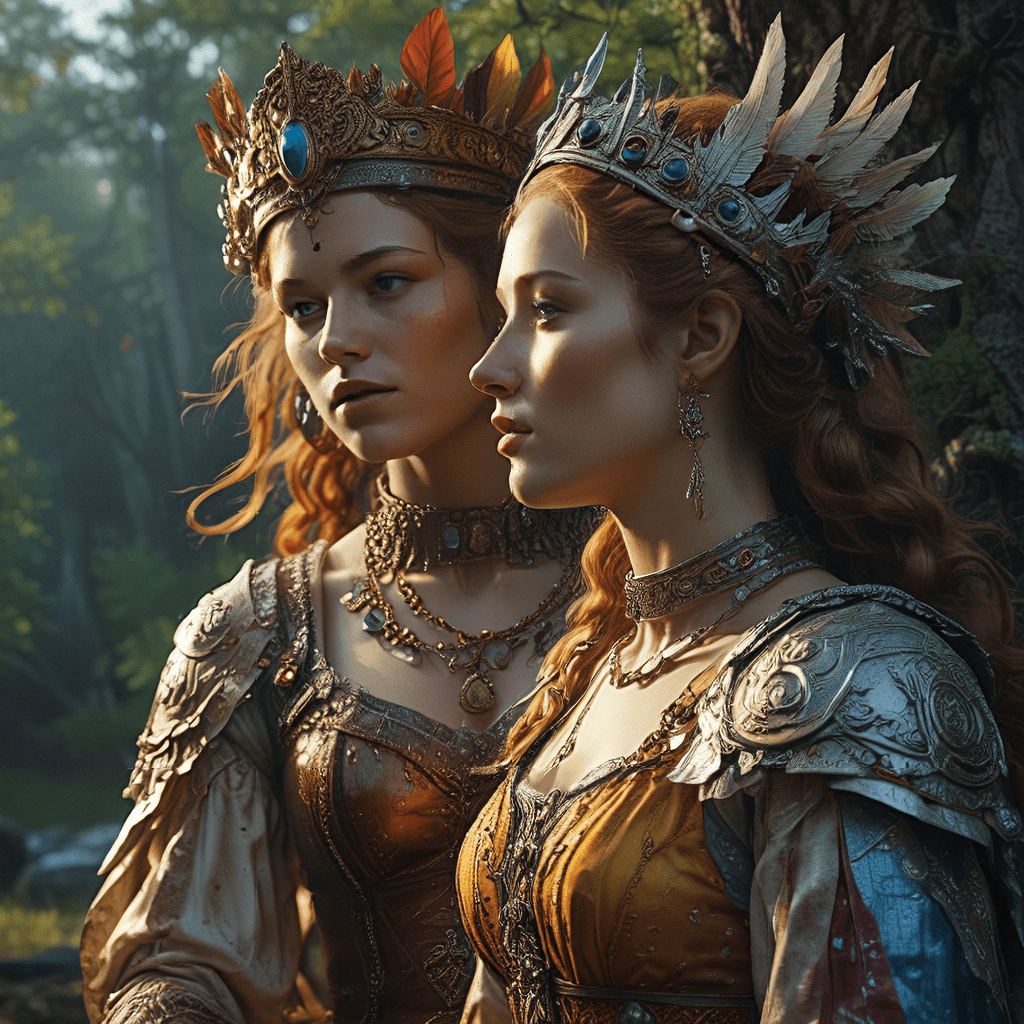The Symbolism of Colors in Baltic Mythological Narratives
The vibrant tapestry of Baltic mythology is intricately woven with symbolism, and color plays a significant role in conveying meaning, emotions, and beliefs. From the shimmering white of the divine to the deep blue of the unseen, each color holds a unique significance in these ancient stories, offering a glimpse into the worldview of the Baltic people. By exploring the symbolism of color in these narratives, we unlock a deeper understanding of their beliefs, rituals, and experiences.
Introduction: Exploring the Tapestry of Baltic Mythology
Baltic mythology, encompassing the rich traditions of Latvia, Lithuania, and Estonia, is a vibrant repository of ancient stories, myths, and legends. These narratives, passed down orally for generations, reflect a deep connection to nature, the forces of the universe, and the search for meaning in life. Baltic mythology is not merely a collection of fantastical tales, but a reflection of the worldview of the people, offering insights into their beliefs about the world, the gods, and the human condition. Color, as a powerful visual element, plays a crucial role in these stories, adding depth and meaning to the characters, events, and settings.
The Role of Color in Baltic Folklore: A Window into Belief Systems
Color symbolism in Baltic mythology is not merely decorative, but deeply intertwined with cultural beliefs, religious practices, and daily life. Colors were understood to hold symbolic significance, reflecting the interconnectedness of nature, the divine, and the human experience. The use of color in dress, rituals, and everyday objects was a visual language that communicated beliefs, status, and even spiritual connections. For example, the color red was associated with fire, passion, and sacrifice, reflecting the importance of these elements in Baltic culture. By understanding the symbolic meanings assigned to different colors, we can decode the deeper meanings embedded in Baltic folklore.
White: Purity, Light, and the Divine
In Baltic mythology, white is a color of purity, light, and the divine. It represents the brilliance of the sun, the innocence of new beginnings, and the spiritual realm. White is often associated with deities, particularly those associated with light, such as the sun god Saule. The white color of dawn symbolizes new beginnings, hope, and the triumph of light over darkness. In rituals and ceremonies, white clothing was worn to signify purity and connection to the divine. White is also associated with the gods of the sky and the heavens, signifying their power and their connection to the forces of nature.
Black: Darkness, Death, and the Underworld
Black, in contrast to white, represents darkness, death, and the underworld in Baltic mythology. It is associated with night, the unseen, and the mysteries that lie beyond the realm of the living. Black is seen as a color of mourning, reflecting the finality of death and the transition to the afterlife. The underworld, ruled by the god Velnias, is often depicted as a dark and shadowy realm, symbolizing the unknown and the forces that lie beyond human understanding. However, black can also represent wisdom, knowledge, and the potential for transformation. Just as darkness precedes the dawn, black can symbolize a journey into the unknown, a space for reflection and growth.
Green: Life, Vegetation, and Fertility
Green in Baltic mythology is a vibrant color associated with life, vegetation, and fertility. It represents the flourishing of nature, the cycle of growth, and the power of the earth. Green is often linked to the goddess of earth and fertility, Žemyna, who is believed to hold dominion over the land's bounty. The green of forests, meadows, and fields symbolizes the abundance of life and the interconnectedness of all living things. In Baltic folklore, green is also associated with healing, rejuvenation, and the life-giving power of nature. Trees, especially those with green leaves, are seen as sacred and possess magical powers.
Blue: Water, Sky, and the Unseen
Blue in Baltic mythology represents the expansive realms of water and sky, symbolizing the vastness of the universe and the mystery of the unseen. It is associated with the god Perkunas, the thunder god, who controls the storms and rains, bringing both life and destruction. The blue of the sky represents the heavens, a realm of deities and spiritual powers. It also symbolizes the vastness of the sea, a source of both bounty and danger, representing the unknown and the forces that lie beyond human control. Blue is often associated with magic, dreams, and the spiritual realm, reflecting the connection between the seen and unseen worlds.
Yellow: Gold, Sun, and Power
Yellow in Baltic mythology is a color of gold, the sun, and power. It represents the warmth of the sun, the preciousness of gold, and the strength associated with leadership and royalty. The yellow of the sun, a life-giving force, is often linked to the sun god, Saule, who brings light and warmth to the world. Yellow is also associated with prosperity, abundance, and the wisdom gained through experience. In Baltic folk tales, yellow is often used to describe the clothing of heroes and rulers, emphasizing their status and their connection to the divine.
Theories of Color Symbolism: Evolutionary and Cultural Perspectives
The symbolism of colors in Baltic mythology, like many other cultures, is likely influenced by both evolutionary and cultural factors. From an evolutionary perspective, certain colors, like red, might have been associated with danger, fire, and blood, leading to symbolic associations with passion, sacrifice, and even aggression. On the other hand, cultural factors, including religious beliefs, social structures, and daily life, played a crucial role in shaping the specific meanings attributed to colors. For example, the importance of agriculture in Baltic society likely contributed to the strong association between green and fertility.
Color as a Tool of Narrative and Character Development
In Baltic folklore, color is not merely a decorative element but a potent tool for shaping narratives and developing characters. The use of color in descriptions, imagery, and symbolism creates deeper layers of meaning, enhancing the emotional impact of stories and reinforcing cultural values. For example, a character dressed in white might represent purity and goodness, while a character clad in black could symbolize darkness, evil, or the underworld. Color, in this way, becomes a visual language that enriches the storytelling experience and strengthens the connection between the narrative and the audience.
The Impact of Color Symbolism on Contemporary Baltics
The symbolism of colors in Baltic mythology continues to exert a powerful influence on contemporary Baltic culture, influencing art, design, fashion, and even personal expression. For example, the color green, associated with nature and fertility, is often used in national symbols and design, reflecting the deep connection to the land. The use of color in folk costumes, traditional textiles, and contemporary art continues to reflect the cultural values and beliefs embedded in these ancient narratives. In many ways, the symbolism of colors acts as a bridge between the past and the present, connecting contemporary Baltic societies to their rich cultural heritage.
FAQ
1. What are some common colors used in Baltic mythology?
Some of the most common colors used in Baltic mythology include white, black, red, green, blue, and yellow. Each color carries a specific symbolism that reflects the cultural beliefs and values of the Baltic people.
2. How does color symbolism impact the stories of Baltic mythology?
Color symbolism plays a crucial role in enhancing the narrative, developing characters, and conveying deeper meanings. The use of color helps to create a more immersive and impactful storytelling experience, reinforcing cultural values and beliefs.
3. Why is the color white so important in Baltic mythology?
White is associated with purity, light, and the divine. It represents the brilliance of the sun, the innocence of new beginnings, and the spiritual realm. It is often associated with deities, particularly those associated with light, such as the sun god Saule.
4. What does the color red symbolize in Baltic mythology?
Red is associated with fire, passion, and sacrifice. It represents the powerful force of fire, the intensity of emotions, and the act of offering something precious to the gods.
5. How does the color symbolism of Baltic mythology relate to the modern Baltic culture?
The symbolism of colors in Baltic mythology continues to influence contemporary Baltic culture, influencing art, design, fashion, and personal expression. The use of color in folk costumes, traditional textiles, and contemporary art reflects the cultural values and beliefs embedded in these ancient narratives.



